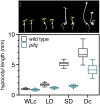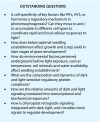Seedling Establishment: A Dimmer Switch-Regulated Process between Dark and Light Signaling
- PMID: 29217596
- PMCID: PMC5813566
- DOI: 10.1104/pp.17.01460
Seedling Establishment: A Dimmer Switch-Regulated Process between Dark and Light Signaling
Abstract
A balance between dark and light signaling directs seedling establishment through integrating internal and environmental information.
Figures









Similar articles
-
Light-induced gradual activation of photosystem II in dark-grown Norway spruce seedlings.Biochim Biophys Acta. 2016 Jun;1857(6):799-809. doi: 10.1016/j.bbabio.2016.02.009. Epub 2016 Feb 18. Biochim Biophys Acta. 2016. PMID: 26901522
-
Light signaling controls nuclear architecture reorganization during seedling establishment.Proc Natl Acad Sci U S A. 2015 May 26;112(21):E2836-44. doi: 10.1073/pnas.1503512112. Epub 2015 May 11. Proc Natl Acad Sci U S A. 2015. PMID: 25964332 Free PMC article.
-
Light control of three-dimensional chromatin organization in soybean.Plant Biotechnol J. 2024 Sep;22(9):2596-2611. doi: 10.1111/pbi.14372. Epub 2024 May 19. Plant Biotechnol J. 2024. PMID: 38762905 Free PMC article.
-
Seedling development in buckwheat and the discovery of the photomorphogenic shade-avoidance response.Plant Biol (Stuttg). 2013 Nov;15(6):931-40. doi: 10.1111/plb.12077. Epub 2013 Sep 24. Plant Biol (Stuttg). 2013. PMID: 24112603 Review.
-
Sensing of UV-B radiation by plants.Plant Signal Behav. 2012 Aug;7(8):999-1003. doi: 10.4161/psb.20815. Epub 2012 Jul 3. Plant Signal Behav. 2012. PMID: 22751358 Free PMC article. Review.
Cited by
-
The evolutionarily conserved kinase SnRK1 orchestrates resource mobilization during Arabidopsis seedling establishment.Plant Cell. 2022 Jan 20;34(1):616-632. doi: 10.1093/plcell/koab270. Plant Cell. 2022. PMID: 34755865 Free PMC article.
-
Role of plastids and mitochondria in the early development of seedlings in dark growth conditions.Front Plant Sci. 2023 Sep 29;14:1272822. doi: 10.3389/fpls.2023.1272822. eCollection 2023. Front Plant Sci. 2023. PMID: 37841629 Free PMC article. Review.
-
Developmental pleiotropy of SDP1 from seedling to mature stages in B. napus.Plant Mol Biol. 2024 Apr 20;114(3):49. doi: 10.1007/s11103-024-01447-8. Plant Mol Biol. 2024. PMID: 38642182
-
GENOMES UNCOUPLED1-independent retrograde signaling targets the ethylene pathway to repress photomorphogenesis.Plant Physiol. 2021 Feb 25;185(1):67-76. doi: 10.1093/plphys/kiaa015. Plant Physiol. 2021. PMID: 33631804 Free PMC article.
-
Direct phosphorylation of HY5 by SPA kinases to regulate photomorphogenesis in Arabidopsis.New Phytol. 2021 Jun;230(6):2311-2326. doi: 10.1111/nph.17332. Epub 2021 Apr 6. New Phytol. 2021. PMID: 33686674 Free PMC article.
References
-
- Bae G, Choi G (2008) Decoding of light signals by plant phytochromes and their interacting proteins. Annu Rev Plant Biol 59: 281–311 - PubMed
-
- Bajracharya D, Schopfer P (1979) Effect of light on the development of glyoxysomal functions in the cotyledons of mustard (Sinapis alba L.) seedlings. Planta 145: 181–186 - PubMed
-
- Ballaré CL, Pierik R (2017) The shade-avoidance syndrome: multiple signals and ecological consequences. Plant Cell Environ 40: 2530–2543 - PubMed
Publication types
MeSH terms
Substances
LinkOut - more resources
Full Text Sources
Other Literature Sources

